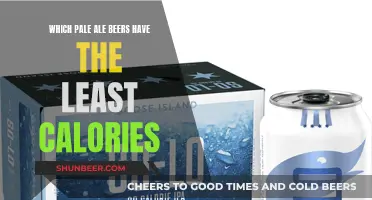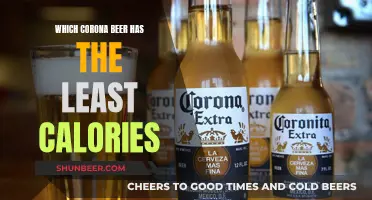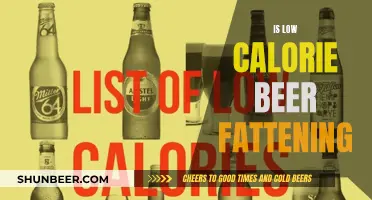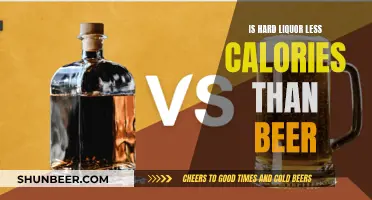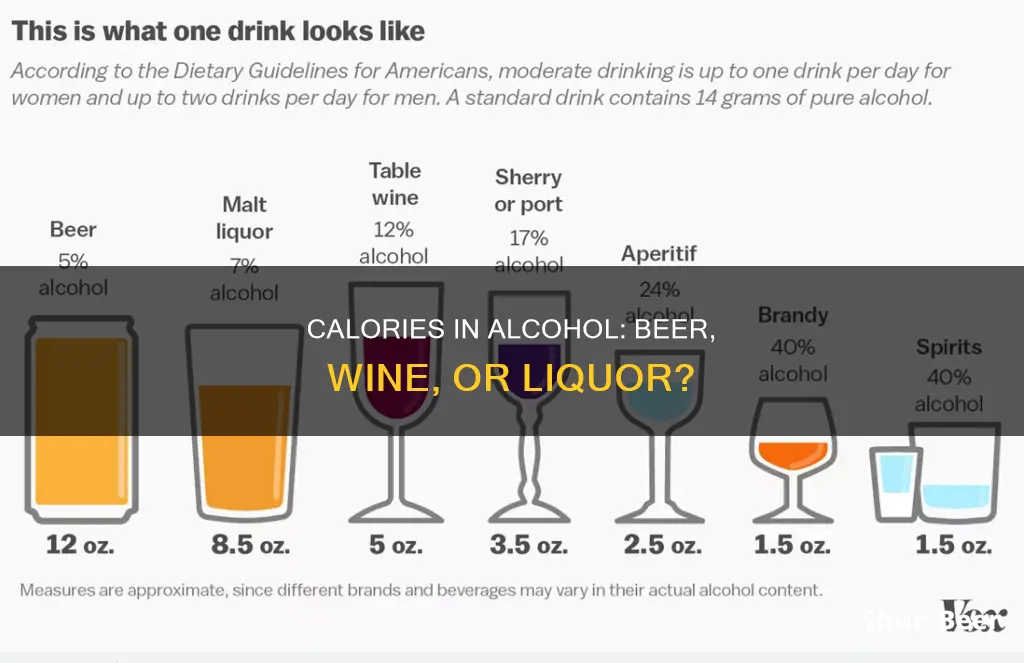
Alcoholic drinks are known to be calorie-dense, with little to no nutritional value. Cocktails mixed with soda, juice, cream, or ice cream can be especially high in calories. Beer, wine, and liquor all have distinct differences in flavour and nutritional values. So, which one has the least calories?
A typical 12 oz beer has 140 calories, which is as many as a can of Coke. The calories in beer depend mostly on alcohol content and, to a lesser extent, on carbs. An average 5% alcohol beer has around 150 calories. On the other hand, a 175ml glass of 12% ABV wine has around 133 calories. A shot of spirits, such as vodka, gin, rum, or whiskey, has 100-120 calories.
Which has the least calories: beer, wine, or liquor?
| Characteristics | Values |
|---|---|
| Beer | A 12-oz beer has around 140 calories, with light beers having 60-120 calories and dark beers having 100-300 calories. |
| Wine | A 5-oz glass of dry wine has around 120-125 calories. A 175ml glass of 12% ABV wine has around 133 calories. |
| Liquor | A 1.5-oz shot of spirits (vodka, gin, rum, whiskey, or tequila) has around 97-120 calories. |
What You'll Learn

Beer calories depend on alcohol content and carbs
Very-low-alcohol beers (2% to 3% alcohol) like Miller 64 have around 60 calories in a 12-ounce serving. Most lights (4% alcohol) have about 100 calories. Bud Light Next has 80 calories and achieves this by reducing alcohol content and dropping carbs to zero.
An average 5% alcohol beer like Budweiser has around 150 calories. Heavy hitters (7% to 11% alcohol) like IPAs, double or imperial IPAs, and Belgian-style Trippels pack 200 to 300 calories. A lower-alcohol “session” IPA has around 140 calories. Newer "lo-cal" IPAs like Dogfish Head Slightly Mighty have as few as 100 calories.
Even an average beer hits 200 or 250 calories when served in a 16 or 20-ounce glass. Lighter colour beers tend to contain fewer calories than their darker counterparts. This is because lighter beers have a lower alcohol content and lower ingredient density. For example, most light beers tend to have between 60 and 120 calories, while dark beers have between 100 and 300 calories due to being more carbohydrate-heavy.
The NHS estimates that drinking five pints of lager each week adds up to 44,200 calories over a year, the equivalent of eating 221 doughnuts! However, the nutritional value of beer exceeds that of wine, with beer often containing protein, fibre, B vitamins, folate, and niacin.
Calorie Count of Bud Ice Beer: What You Need to Know
You may want to see also

Wines with higher alcohol content have more calories
Alcoholic drinks are not exactly nutritious, and consuming them can make it challenging to lose weight. However, some alcoholic drinks are more waistline-friendly than others.
The calorie content of wine is influenced by its alcohol and sugar content. Alcohol contains more calories per 100ml than carbohydrates, so wines with higher alcohol content usually have more calories than sweeter wines. For example, a standard 175ml glass of 12% ABV wine contains around 133 calories, while a 5% ABV pint of beer contains around 240 calories.
Red wine tends to have a higher alcohol content than other types of wine, so it usually contains more calories. A 6-ounce pour of red or white wine, the amount typically served in restaurants, contains roughly 150 calories. A 9-ounce glass of red or white wine contains around 220 calories.
Lighter wines, such as Barefoot Bright & Breezy or Cupcake Light Hearted, have lower alcohol content, around 6% to 8%, which cuts the calories to 70 to 80 per 5-ounce glass.
If you're looking for a drink with fewer calories, a shot of spirits is a good option. A 1.5-ounce shot of vodka, gin, rum, whiskey, or tequila contains an average of 97 to 120 calories. A glass of champagne is another low-calorie choice, with about 84 calories per 4 ounces.
Beer generally has more calories than wine due to its leftover carbohydrates, but low-calorie beers are available. These beers have an additional enzyme added during brewing or fermentation that breaks down starch molecules, resulting in no remaining carbohydrates. They also have a relatively low alcohol content, keeping the total calorie count low.
Cheese Soup Calories: Beer's Influence on Fitness Goals
You may want to see also

Pure alcohol has 7 calories per gram
Alcoholic drinks can be deceiving when it comes to calories. While they may not have nutritional labels, alcoholic drinks can easily rack up empty calories. Pure alcohol has 7 calories per gram, which is almost as many as a gram of fat, which has 9 calories per gram. This means that a standard 175ml glass of 12% ABV wine, which contains around 133 calories, is equivalent to eating three Jaffa Cakes.
The number of calories in a drink depends on its alcohol and sugar content. A higher alcohol content means a higher number of calories. For example, a 12-ounce light beer has only 103 calories, while a regular beer of the same size has 153 calories. Similarly, a pint of 5% ABV beer has around 240 calories, while a pint of stronger lager can have up to 222 calories.
The colour of the wine also makes a difference. Red wine tends to have a higher alcohol content, and thus more calories, than white or rosé wine. A 5-ounce glass of pinot noir has 121 calories, while a similar glass of Burgundy, cabernet sauvignon, or merlot has 122 calories.
Liquor also has calories. A shot of gin, rum, tequila, vodka, or whiskey has 100 to 120 calories per 1.5-ounce shot. This is because all of the calories in liquor come from its alcohol content, which ranges from 40% to 50%.
So, if you're watching your weight, it's important to consider not just what you're eating but also what you're drinking. Alcoholic drinks can easily add empty calories to your diet and may lower your inhibitions, causing you to consume more food.
Low-Calorie Beer Options for the Health-Conscious Drinker
You may want to see also

Low-calorie beers have additional enzymes to break down starch
Beer, wine, and liquor all have different calorie counts, depending on their alcohol content, volume, carbohydrates, sugars, and mixers. Pure alcohol contains 7 calories per gram, while protein and carbs have 4 calories per gram, and fat has 9 calories per gram.
Beer is made from grain, which stores carbohydrates in the form of starch. These starches are large, branched sugar molecules, which are chopped into pieces by naturally occurring enzymes in malted barley during the brewing process. The smallest sugar pieces are converted to alcohol by yeast, but some larger pieces remain that cannot be broken down by yeast, and these remaining carbohydrates contribute to the overall calorie count for most beers.
Low-calorie beers are made using a few different techniques. One method is to simply use ingredients that make the beer lighter overall, such as grains like wheat and rice. Another method is to use higher fermentation temperatures, which reduce the beer's alcohol content and, in turn, its calories. A third technique is to include additional enzymes to break down dextrins, which are stubborn starch molecules that remain intact through the brewing process and are not fermentable. By breaking down these dextrins, the overall calorie count of the beer is lowered.
The additional enzymes used in low-calorie beers target dextrins, which are complex carbohydrates that the yeast cannot ferment. During the brewing process, the enzymes break down these dextrins into simpler sugar molecules. This is beneficial because the yeast can then ferment these simpler sugars into alcohol, reducing the amount of unfermented carbohydrates remaining in the beer. This results in a beer with fewer calories.
Critics of low-calorie beers argue that the taste is compromised in the process. By reducing the carbohydrate and alcohol content, the flavour may become more subtle and less brassy. However, some people prefer the lighter taste of low-calorie beers, and the health benefits they offer can be appealing to those watching their weight.
Calories in Crown Lager Beer: Nutritional Breakdown
You may want to see also

Spirits are relatively low-calorie
Spirits are relatively low in calories. Vodka, for instance, has 64 calories per ounce, tequila has 69, gin has 74, scotch has 80, and rum has 97. These spirits have zero carbs, but the calorie count can increase depending on what you mix them with. For instance, tonic water contains added sugar and, therefore, more calories. A healthier option would be to mix spirits with sparkling water, which has zero calories and zero sugar.
If you're looking for the lowest-calorie alcoholic option, a hard seltzer is a good choice. This is a drink made by combining seltzer water with alcohol from fermented cane sugar. A 12-ounce serving of mango hard seltzer has only 148 calories.
Another low-calorie option is light beer, which has fewer calories and a lower alcohol content than regular beer. A 12-ounce can of light beer usually has about 60-120 calories.
Red wine is also a relatively healthy option. Research has shown that the active compounds in red wine improve overall heart health. A glass of red wine has around 150 calories.
Calorie Count in Bira White Beer: Know Before You Drink
You may want to see also
Frequently asked questions
Liquor has the least calories, with a 1.5-ounce shot of spirits like vodka, gin, rum, whiskey, or tequila containing an average of 97 to 120 calories.
The calorie content of beer varies depending on the type, but on average, a pint of 5% ABV beer contains around 240 calories. Lighter beers typically have fewer calories than darker beers.
The calorie content of wine depends on the type and colour, but on average, a 175ml glass of 12% ABV wine contains around 133 calories. Rosé wine has around 70-80 calories per 100ml, white wine has 73-83 calories per 100ml, and red wine contains between 75-85 calories per 100ml.
Alcoholic drinks provide little to no nutritional value and can make it challenging to lose weight.
Some lower-calorie options include light beer (around 100 calories), reduced-calorie wine (about 90-100 calories), and champagne (approximately 84 calories per 4 ounces).



